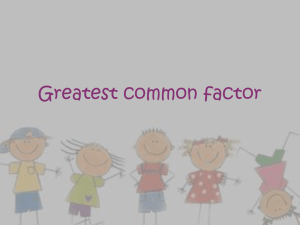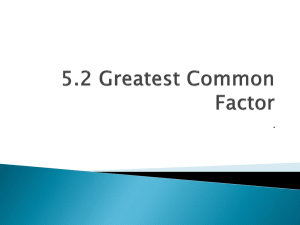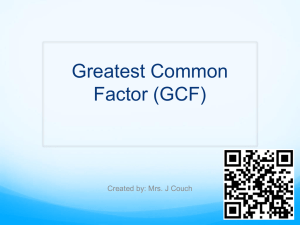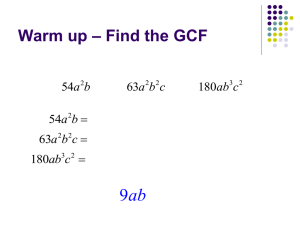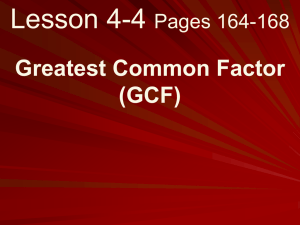1st strategic objective facilitating high
advertisement
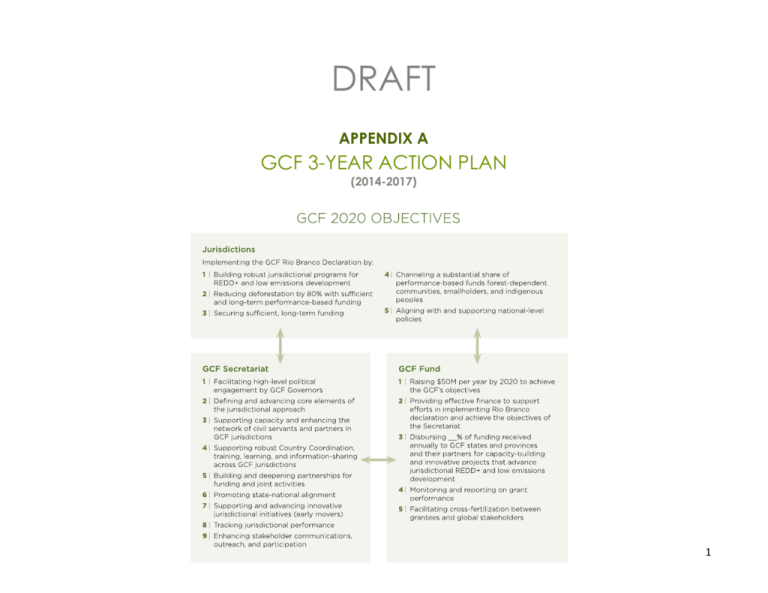
DRAFT APPENDIX A GCF 3-YEAR ACTION PLAN (2014-2017) 1 DEFINITIONS OBJECTIVE: What do you want to do? OUTCOME: Why do you want to do it? INDICATOR: How will you know you succeeded? 1ST STRATEGIC OBJECTIVE FACILITATING HIGH-LEVEL POLITICAL ENGAGEMENT BY GCF GOVERNORS OUTCOMES The GCF supports the GCF Governors efforts to provide strategic leadership to the GCF and the broader climate and forest policy community INDICATORS – – – – – – – The GCF creates opportunities for high-level engagement that result in change – – – – – – – GCF develops packet of materials for new Governors/Administrations GCF Governors are well-informed about the GCF GCF Governors endorse the Rio Branco Declaration GCF Governors put resources behind implementing the Rio Branco Declaration GCF Governors advocate the positions of the GCF at > 2 international meetings annually GCF Governors actively participate in the UNFCCC process (including national UNFCCC COP preparations to extent feasible) GCF Governors develop shared policy objectives and recommendations for their countries that they communicate with their national governments (including input on the design of UNFCCC results-based payment mechanism) >85% of Governors are involved in GCF policy agenda every year Governors reference their involvement in the GCF in external communications GCF has a communications and action strategy for UNFCCC COPs (e.g. 2014 in Peru and 2015 COP in Paris) GCF organizes official and/or off-site events at all UNFCCC GCF identifies events organized by other organizations at COP where Governors and representatives can participate GCF sends delegations to other key international meetings/discussion spaces (CarbonExpo, NACW, commodity roundtables, supply chain efforts, etc) GCF Coordinators convene Annual Meetings of the GCF Governors in their regions to define leadership goals, to generate collective positions and proposals, and to identify leading Governors for region to help with governor 2 – outreach GCF Governors and/or delegates are influencing policy decisions as evidenced by 2 policy publications, 2 meetings with state secretaries/legislators, and 2 meetings with national ministries per region per year to communicate GCF positions, best practices and recommendations. 2ND STRATEGIC OBJECTIVE DEFINING AND ADVANCING CORE ELEMENTS OF THE JURISDICTIONAL APPROACH OUTCOMES GCF jurisdictional REDD+ Framework/Performance Metric guides GCF Members about how to develop, finance, and implement low emissions development programs with strong social and environmental safeguards INDICATORS – – – – – – – GCF is recognized as a driver of national, regional, and international REDD+ and low emissions development policies and initiatives. GCF works with existing standards organizations to simplify and communicate those standards to its Members GCF completes and disseminates GCF Framework/Performance Metric to its Members Workshops/training/webinars held on Framework/Performance Metric >60% of GCF tropical forest jurisdictions are accessing performance-based funding from the GCF Fund and other sources using the Framework/Performance Metric by March 1, 2017 > 60% jurisdictions are implementing REDD+/LED programs that are consistent with the Framework/Metric by March 1 2017 GCF ensures Framework/Metric socialized and aligned with national policies accounting systems by meeting with national officials, engaging in targeted training and outreach GCF engages with emerging compliance markets about Framework/Metric and opportunities for partnership – Members issue an Annual Brief that describes their successful instruments/approaches that may be replicated in other member states – GCF implements the commitments of the Rio Branco Declaration, including establishing reference levels in all tropical forest GCF states and provinces (using the Framework/Metric) GCF develops innovative partnerships with sustainable supply chain efforts and Indigenous Peoples organizations – 3 GCF states and provinces have the support they need to implement robust jurisdictional REDD+ and low emissions development programs – – GCF expands its scope to encompass low emissions development activities broadly – – – – GCF regularly assesses the needs of its Members to create enabling conditions for low emissions economies and directs available resources to address those needs, with the following member-identified indicators of success: o GCF tropical forest states and provinces reduce deforestation by 80% by 2020 o GCF tropical forest states and provinces increase forest cover by at least 30% by 2020 o GCF Members improve livelihood productivity by __% by 2020 o Where relevant, GCF Members have increased the use of fuel-efficient energy sources by 40% by 2020 o GCF Members establish Climate Change Commissions o GCF Members harmonize agriculture and forestry policies o GCF Members provide capacity-building to local institutions in forestdependent communities, including for community land use, forest management, and action plans GCF supports participatory stakeholder processes for low emissions development GCF identifies areas for expansion and activities/funding for doing so at Annual Meeting GCF develops best practice approaches to climate-friendly agriculture GCF develops best practice approaches to stakeholder participation and benefit-sharing 3RD STRATEGIC OBJECTIVE SUPPORTING CAPACITY AND ENHANCING THE NETWORK OF CIVIL SERVANTS AND PARTNERS IN GCF JURISDICTIONS OUTCOMES A high-level of capacity (technical, institutional, policy) is achieved in all GCF jurisdictions INDICATORS – – – – GCF Framework/Metric (see above) outlines core elements of jurisdictional programs GCF regularly assesses member capacity-building needs in relation to these core elements GCF Training Program responds to member needs and interests and is developed in conjunction with Coordinators, experts, and local input Training program 4 Trains significant number of GCF civil servants Includes indigenous peoples and other forest-dependent community representatives o Includes “Training of the Trainers” and pilot projects for information and technology dissemination o Explores partnership with local universities to develop curricula and other projects o Records and posts events using multimedia (distance learning?) o Documents and synthesizes lessons learned in GCF Training Program Handbook o Develops regional information management networks to harmonize approaches, promote information sharing, and solicit feedback o Considers an Intensive Forest and Climate Change Management Course (a high-level 5-day course where forest and climate change managers from member states are trained and share experiences) GCF expands and Improves GCF Network by o Mapping all member jurisdictions o Increasing awareness and use of Support Network o Building a directory of experts o Enhancing the functionality and utility of the tools o o GCF Support Network strengthens relationships within and between GCF jurisdictions and their stakeholders – 4TH STRATEGIC OBJECTIVE SUPPORTING ROBUST COUNTRY COORDINATION, TRAINING, LEARNING, AND INFORMATION-SHARING ACROSS GCF JURISDICTIONS OUTCOMES Effectiveness of GCF country and regional coordination is improved and facilitates learning and action by Members INDICATORS – – – – – Each year, the GCF improves and streamlines communications between Secretariat and Coordinators Annual meeting of Coordinators, Secretariat and Chair held in first quarter of 2015, 2016, and 2017 in Boulder, Colorado The GCF Secretariat engages with Country Coordinators and GCF representatives in their states and provinces through the GCF Regional Strategy & Partnerships Meetings and the GCF Training Program (2015, 2016, 2017) In 2015, the GCF adds secure log-in feature to the GCF website to give GCF Country Coordinators and representatives quick access to important 5 documents and announcements relevant to them The GCF consolidates and ensures added value of all meetings, workshops and trainings – – The GCF Training Program and Support Network increase cross-jurisdictional exchange and innovation diffusion The GCF Knowledge Database promotes information-exchange, transparency, and accountability The GCF Coordinators allocate a significant amount of time in 2015-2017 on (a) high-level political engagement; (b) regional thought leadership and partnership development; and (c) state-national alignment The GCF seeks multi-year funding in 2015, 2016, and 2017 to expand budget for Country Coordination staffing and GCF activities – – See Strategic Objective 3 (Training Program and Support Network) The GCF supports at least 2 learning and exchange visits between GCF Members annually – The GCF develops a budget and procedures for maintaining a robust, highquality, easily accessible, and up to date GCF Knowledge Database by March 2015 The GCF considers other options for information tracking and exchange through 2020 by March 2015 The GCF assesses the ability of its Members to engage in data management/updates and addresses any technological and staffing shortfalls by March 2015 In 2015, the GCF seeks adequate funding to maintain and improve the Knowledge Database or to build and maintain any other option selected – – – 6 The GCF strategically communicates results to facilitate dialogue and learning and increase impact – – The GCF develops a Communications Plan by June 2015 that includes: o Internal approaches New Governor/member informational packet Monthly Secretariat updates Regular member updates to Secretariat Regular national updates from Coordinators Coordinators and Members may develop regional processes for decisionmaking and communication Annual Secretariat-Coordinator-Chair meeting (Boulder, CO) Document translation and circulation guidelines Resources developed by other organizations on GCF topics of interest disseminated (e.g. debates, lectures, videos, courses, etc.) Regular website updates and improvements Regular update of materials (e.g. brochures, etc) o External approaches (how to share information, approaches, best practices, and other developments within and beyond each jurisdiction) Meetings with decisionmakers Updating communications advisors/staff at state/provincial level regarding GCF activities and request that GCF be more fully incorporated into state/province communications and infrastructure Develop content for and partner with online and print national and international media organizations to expand awareness and promote GCF activities Newsletters, fact sheets, brochures, reports sent to regularly updated GCF Contacts list Twitter, Facebook, Flickr Updated GCF website and Knowledge Database Guidelines for when and how to seek outside assistance Regional GCF web pages A targeted approach for exchanging information and engaging with local communities including community radio initiatives GCF Members tailor and use communications plan 7 5TH STRATEGIC OBJECTIVE BUILDING AND DEEPENING PARTNERSHIPS FOR FUNDING AND JOINT ACTIVITIES OUTCOMES Sustained, long-term finance for capacity-building and pay-for-performance activities of the GCF Members is secured through the GCF Fund INDICATORS – – – – – – – Sustained, long-term finance for capacity-building and pay-for-performance activities of the GCF Members is secured through other sources of support and partnerships – – – – – The GCF Fund raises $ 1M USD per GCF member by December 31, 2015 and annually thereafter for continuing Fund activities The GCF Fund uses the Rio Branco Declaration target (80% reductions by 2020) to develop a Fundraising Plan by January 2015 to achieve its fundraising goals The GCF Fund fundraising plan, priorities, and procedures are developed with input and oversight from the GCF Members (and are aligned with national policies) (2015, 2016, 2017) The GCF Fund identifies clusters as part of establishing fundraising priorities The GCF Fund develops a legal analysis of governance options for the Fund, including Board composition, long-term location of the Fund, etc. (2015) [clarify with Brazilians] The GCF Members and Secretariat work closely with Fund staff to develop fundraising policies, assist with fundraising, and track and share activities and results (2015, 2016, 2017) The GCF Fund results are tracked and reported through GCF Knowledge Database or other tracking tool developed (2015, 2016, 2017) The GCF develops a global analysis of the sources of (and procedures for accessing) financing for REDD+ and low emissions development for the GCF and its Members, including a map of donors and their history of contributions (June 2015) The GCF evaluates “pay for performance” assets/opportunities within the GCF’s jurisdictions and develops an innovative pay-for-performance financing Strategy for its Members [2015, need more input from Mariano and determine how this relates to Jurisdictional Framework/Metric discussed above] The GCF develops Public-Private Partnerships to leverage funds and other resources, including by building partnerships with Consumer Goods Forum and other companies working on net deforestation-free supply chains (2015, 2016, 2017) The GCF facilitate exchange between jurisdictions that have had success accessing finance and those looking for financing (2015, 2016, 2017) The GCF engages with other standards organizations (e.g. VCS), int’l institutions (e.g. World Bank), negotiation spaces (e.g. UN CBD), emerging markets (voluntary, compliance), and other initiatives (commodity roundtable, 8 GCF engages with developed country jurisdictions that may provide technical and/or financial support to the GCF Members – – – – GCF solidifies partnerships and collaborations with key public and private sector entities, which increases effectiveness – – – – sustainable supply chain efforts) (2015, 2016, 2017) The GCF maps and tracks demand side jurisdictions with potential interest in offsets (April 2015 and in 2016, 2017) The GCF conducts outreach and organizes meetings with interested jurisdictions (2015, 2016, 2017) The GCF Members develop regional approaches/connections (2015, 2016, 2017) The GCF adds 5 demand side jurisdictions as Members by 2016; and 5 more by 2020 The GCF creates opportunities at the UNFCCC COPs, the GCF Annual Meetings, and other international forums to develop partnerships (2015, 2016, 2017) The GCF conducts individualized outreach to Consumer Goods Forum and other companies with relevant supply chain activities in GCF jurisdictions The GCF conducts individualized outreach to Indigenous Peoples organizations, including COICA and MADN (2015, 2016, 2017) Partnerships result in tangible outcomes (low emissions development results) (2016, 2017) 6TH STRATEGIC OBJECTIVE PROMOTING STATE-NATIONAL ALIGNMENT OUTCOMES GCF Members are engaging with national ministries, agencies, and decisionmakers and aligning state and national policies and activities INDICATORS – – – – – – The GCF Members actively participate in national REDD+/LED processes on an annual basis The GCF tracks, understands, and takes advantage of the key opportunities for input to national processes (2015, 2016, 2017) GCF Country Coordinators facilitate interactions between their jurisdictions and national entities by identifying key national contacts, communicating with them regularly, requesting in person meetings with them, and inviting them to GCF events (2015, 2016, 2017) The GCF identifies key national-level meetings and creating opportunities for GCF speakers/attendees (2015, 2016, 2017) The GCF Fund identifies and is consistent with member countries’ economic development polices and processes (2015, 2016, 2017) See also 1st Strategic Objective indicators for high-level engagement 9 7TH STRATEGIC OBJECTIVE SUPPORTING AND ADVANCING INNOVATIVE JURISDICTIONAL INITIATIVES (EARLY MOVERS) OUTCOMES The GCF is advancing innovation and linking early movers with new partners. INDICATORS – – – – The GCF is diffusing innovative practices throughout its membership. – – The GCF Fund is supporting early movers, which can demonstrate how REDD+ and low emissions development can work in practice. – – The GCF raises the profile of advanced jurisdictional programs and early movers (2015, 2016, 2017) The GCF links advanced jurisdictional programs and early movers with financial and technical partners (2015, 2016, 2017) The GCF updates policymakers and regulators in California and elsewhere about the progress made in specific GCF jurisdictions and the potential for linkage with these jurisdictions (2015, 2016, 2017) See also Objective 4 (connecting Members with donor governments, civil society partners, private sector actors, and Indigenous Peoples organizations to develop innovative partnerships and initiatives across key GCF jurisdictions) The GCF compiles lessons and best practices from innovative efforts to build jurisdictional programs for low emissions development and effectively delivers this information to the GCF’s Members See also Objectives 3 (Capacity & Network), 4 (Information-sharing), 5 (Partnerships) The GCF Fund continues to grow and receive additional contributions by early 2015 and into 2016, 2017 that can be allocated to address collective needs across the GCF and support innovative initiatives in specific GCF jurisdictions. See also Objective 5 (Fund provisions) 8TH STRATEGIC OBJECTIVE TRACKING JURISDICTIONAL PERFORMANCE OUTCOMES The GCF documents progress toward the Rio INDICATORS – The GCF establishes simple indicators to measure the extent to which GCF 10 Branco Declaration commitments Members: o Build robust jurisdictional programs; o Reduce deforestation relative to established reference levels; o Secure long-term adequate financing; o Channel a substantial share of performance-based funds to Indigenous Peoples, smallholders and forest-dependent communities; and o Align with, and support, national-level policies. – The GCF tracks progress on these indicators through an improved GCF Knowledge Database or other mechanism (see Objective 4 Knowledge Database provisions) 9TH STRATEGIC OBJECTIVE ENHANCING STAKEHOLDER COMMUNICATIONS, OUTREACH, AND PARTICIPATION OUTCOMES The GCF supports inclusive decisionmaking in GCF states and provinces The GCF increases its visibility with local and global stakeholders and their participation in GCF activities The GCF engages with stakeholder processes, which facilitates implementation of the Rio Branco Declaration INDICATORS – – – – – – – – The GCF develops Communications Plan (see Strategic Objective 4 under strategic communications outcome) The GCF creates exchange opportunities with stakeholders in host jurisdiction of the Annual Meeting well in advance of the Meeting o Knowledge gaps and communications opportunities identified o Information about previous meeting/minutes and current objectives shared with stakeholders in advance of meeting o Stakeholders involved in agenda development o Meeting feedback disseminated The GCF implements its Communications Plan (see Strategic Objective 4) GCF’s capacity-building and coordination efforts (Training Program, Regional Strategy and Partnership Meetings, Annual Meetings and Country Coordination) continue to be the primary platforms for continued engagement and participation of stakeholders from government, civil society, academia, communities and the private sector See also Objective 6 (Partnerships) The GCF reviews, tracks, and communicates existing processes The GCF identifies need and provides support for new/additional processes including through Public-Private Partnerships The GCF strengthens local community decisionmaking institutions [practical?] 11 – – – The GCF Members engage local community and other forest stakeholders in mapping and jurisdictional policy-making processes The GCF promotes the rights of forest dependent communities to forests, the use of forest resources, and carbon [other related to Rio Branco Declaration? The GCF’s own process?] 12

